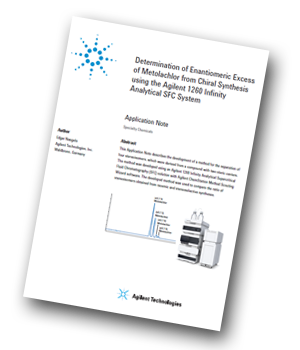Agilent Technologies has produced an application note describing the development of a method for the separation of four stereoisomers, which were derived from a compound with two steric centers. The method was developed using an Agilent 1260 Infinity Analytical Supercritical Fluid Chromatography (SFC) solution with Agilent ChemStation Method Scouting Wizard software. The developed method was used to compare the ratio of stereoisomers obtained from racemic and stereoselective syntheses.
 Introduction
Introduction
In this Application Note, we demonstrate how a method for the separation of all four stereoisomers of metolachlor can be developed using the Agilent 1260 Infinity Analytical SFC Solution. The developed method is able to separate the four stereoisomers within a much shorter time than typically needed for the separation using normal phase HPLC conditions. In addition, the SFC method avoids using
harmful solvents.
Results and Discussion
A racemic mixture of metolachlor comprising all four stereoisomers was used for a screening with four different chiral columns and three organic modifiers of increasing eluting strength; isopropanol, ethanol, and methanol. Three different isocratic conditions were used for the initial screening with 5, 10, and 20 % of the organic modifier. The screening of one column with three different solvents and three different isocratic compositions took about 90 minutes, including solvent exchange and equilibration. The most promising elution pattern obtained by the screening process was achieved on the Chiralpak IA3 column.
Conclusion
This Application Note demonstrates the development of a method for the chiral separation of a compound, the pesticide metolachlor, with more than one chiral center and, hence, more than two
enantiomers. The final method was used to determine the enantiomeric excess of the product from stereoselective synthesis. The developed method had a run time of 10 minutes. In contrast, the typical normal phase HPLC method takes at least 30 minutes. The SFC method is about three-times faster than a classically used normal phase method. In addition, compared to the normal phase method, the SFC does not use harmful solvents such as n-hexane. The obtained retention time RSD values were below 0.2 %, and area RSD values were about 1 %.




